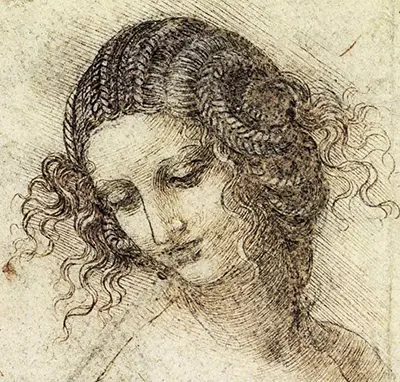His painting Leda and the Swan is one of his most well known works of art, and it was painted at the time that he was also working on the Mona Lisa.
Examining Study for the Head of Leda gives us an insight into how da Vinci prepared for these later, larger works of art.
It shows us a process of trial and error, and the thought processes of the artist thinking his compositions through. Study for the Head of Leda is also something that we can consider a valuable work of art in and of itself.
Study for the Head of Leda, like all of da Vinci's Leda themed paintings, relates to the classical myth of Leda and the Swan. In the original myth, Leda is raped by Zeus who has disguised himself as a swan, but Renaissance painters often glossed over or ignored the problematic and violent elements of this original myth to depict Leda and the swan as lovers.
Da Vinci is one of them: he dwells on Leda's beauty and the natural surroundings.
Study for the Head of Leda bears some relation to da Vinci's anatomical studies of the head and neck. There is no denying that his work in human anatomy and comparative human-animal anatomy informed his realistic paintings of human and animal forms.
In Study for the Head of Leda, which was created (again, like Leonardo's anatomical works) using pen and ink, we see Leda's head in close up, turned slightly to the side. The pen strokes focus very much on her elaborate coiled braids: a hairstyle that would not have looked out of place in Leonardo's day.
The mix of tight braids and disordered loose sections of hair may be designed to say something about Leda's emotions during the moment in her life captured in this proposed painting. This drawing has been dated to sometime between 1504 and 1506, the time period when Leonardo was getting deeply involved in depicting the myth of Leda and the Swan.
Sadly, the painting that Study for the Head of Leda was supposed to be a preliminary sketch for has been lost. We do have other Leda themed paintings created by Leonardo still in existence in art galleries, as well as a sizeable number of copies of his works and paintings created from his sketches done by other artists.
Nevertheless, the particular painting that Study for the Head of Leda was related to is no longer available to us. Thus, we are left with an intriguing state of affairs, when the preliminary sketch takes the place of the art work and becomes an authoritative document.


